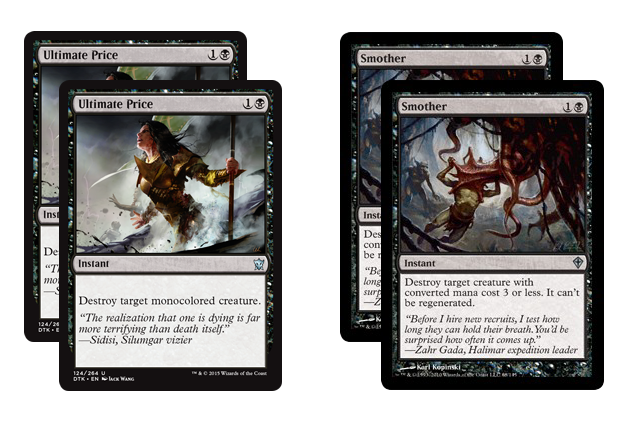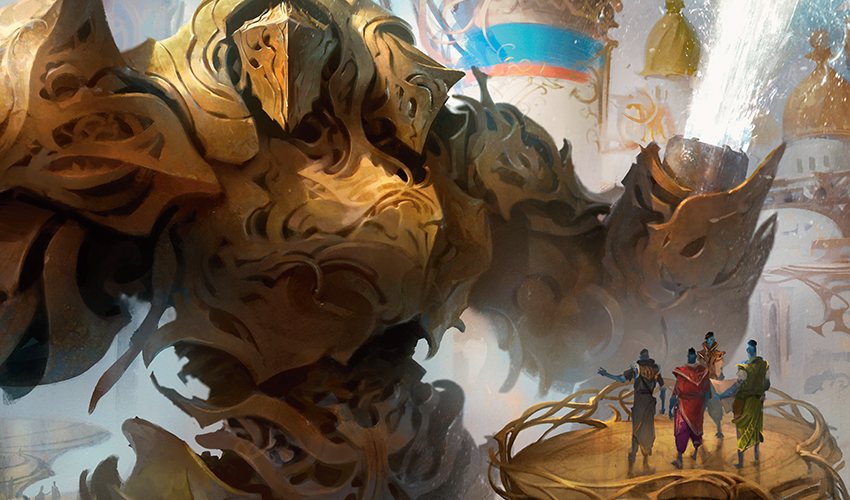Take Two
A little while back, I started a series of articles that each cover when you should put a specific number of cards in your deck. I already covered four copies of a card in "Four of a Kind," and three copies of a card in "Three's Company."
Today, we're going to add a new chapter to that saga. And if you follow the pattern so far (or just read the title of this article), you'll know which one I'll be covering next: two!
So, what might make you want to put two copies of a certain card in your deck?
Two is one of the trickier numbers to deck build with. With four, it's pretty straightforward why you would want that many: you want to draw it as often as possible. With three copies, it means you want to draw it sometimes, and ideally not multiples. But two? Two is a bit of an oddball.
In general, two is a number I generally try not to play many of. Usually when somebody shows me a deck full of two-ofs, it is a sign of an un-tuned deck: you don't know what the right card to play is, so you play some two-ofs to hedge.
But, of course, there are some fine reasons for doing so. Let's go over five common reasons you'll play with two.
1. The Card is Extremely Situational
Some cards are extremely powerful in some matchups, and near-useless in others. Often these are relegated to the sideboard—but not always. Sometimes, the metagame or a weakness in your deck really wants you to have access to some main deck. So, a traditional sideboard card shows up in your main.
For example, let's say that a major element of the metagame are black and/or red aggressive decks. Normally, you would sideboard Surge of Righteousness, but with the popularity of these decks you may want to main deck it.
While Surge is not entirely useless against other decks—maybe you'll run into a midrange deck with some black creatures or something—it's basically only there for those specific decks. It can be an entirely dead card in some matchups.
Well, two copies is a reasonable number to play. You'll find one sometimes, in addition to your other removal, to help you out against these beatdown decks and it will make a significant difference. At the same time, you're extremely unlikely to draw two, meaning that in matchups where the two-of is horrid, you won't clog up on them.
2. The Card is Un-charastically Expensive to Cast in Your Deck
When I was covering three-ofs, I mentioned that a good candidate for a three-of is often something at the top of your deck's curve.
Well, two-ofs are that taken to an extreme.
If there's something really powerful but un-charastically high on the curve, it can be a good candidate for a two-of.
Good examples are these fellows:
Ah—remember the Titans?
The Titans are crazy strong—so much so that they could turn around games which seemed hopeless. However, if you're playing a midrange mono-red deck and you top out at four mana, Inferno Titan is a bit lofty. But, in some games, where you flood out, it can be the game-changer.
Two is a number some red players opted for. You're very unlikely to draw two, so worst case you're down a card you can't cast. And if you do flood or the game goes long, it's the trick up your sleeve to finish the game.
3. Your Deck Has the Time to Find It
Point #2 isn't just true of aggressive or midrange decks, it can be true for control decks as well. However, the big advantage control decks have is that they're built to go long.
When you're playing with card draw and ways to see huge chunks of your deck, such as with Dig Through Time, plus you're delaying the game with removal spells and board sweepers like Murder and Fumigate, that means you have a far better chance of eventually finding any individual card. And that makes control decks a better fit for two-ofs than some others.
A finisher is one place this commonly manifests. Let's take Akroma, Angel of Wrath as an example.
When it comes to super pricy finishers like this legendary Angel, you will have plenty of time to try and find one. You definitely don't want it sitting in your hand early, and it's resilient to removal so you're unlikely to want a second because it's legendary. This is the kind of card you could certainly play two copies of in addition to something else.
And it's not just finishers—maybe you main deck some situational artifact or enchantment removal, or perhaps you have some big life gain spell that you just want to find sometimes to stabilize. All of these can be reasonable choices when your deck is built to go longer.
But hey, while we're circling around the topic of splitting finishers...
4. You're Splitting or Supplementing
When is a two-of not really a two-of? When it's a split!
As I mentioned in Three's Company, a split is a deck building technique used to create diversity in your deck's options. If you're picking between two removal spells with a restriction, for example, you may want to play two of each.

Often, it's better to draw one of each than two of the same card. If they play an Anafenza, the Foremost, you're going to prefer to have the Smother. If they play an Archangel Avacyn, you're going to prefer having the Ultimate Price. Having a greater variety—when appropriate for the metagame—helps you deal with the right threat at the right time.
Similarly, a two-of card be to supplement something else. If you're playing two Lightning Strikes alongside your four Lightning Bolts, then the goal of the Strikes is to act as additional Bolts. So it's not really a two-of them—it's actually more of a six-of!
5. You Don't Have Enough Information
It takes a bit of courage to swallow your pride—but sometimes, you just don't know enough.
Let me put you in a situation.
You're planning on playing white-blue control. You've been slowly working on the deck and figuring out what to play. And then, the night before the tournament you're planning to play it in, you decide to try out Torrential Gearhulk and discover that it's really strong in your specific build.
However, you've only played a handful of games with it. You don't know what matchups might suffer by putting it in, and if you cut other win conditions you might accidentally weaken your deck and make it difficult to win.
One option is to set the Gearhulks aside, and just forgo them for this event. But if you do want to play them, you could try just playing a couple. It's a lot safer: if they are as awesome as you thought, then they're still in your deck to use, but without getting to round two and realizing that you accidentally made it so your deck was significantly worse. (Though I'll note that sticking with the previous build, in many cases, is better if you're really unsure—but that's another article entirely.)
It's a bit of a meta thing to do, but if your goal is to give yourself the best chance while reducing risk, the halfway point is always an option to consider—though far from automatically always the right one.

Double Trouble
While I do generally dislike two-ofs, often when I start building, I'll put several of them into my first draft. Why? Because I want to draw a wide mix of cards and see what works and what doesn't. Then, from there, you can begin to hone further. They give you variety.
I encourage you to try out the same. Ideally, you'd never be in situation #5—and investigating lots of different cards early can go a long way there.
That wraps up my look at two-ofs! With two, three, and four in the books, you can expect one to be not too far in the future.
In the meantime, if you have any thoughts or questions at all, I'd love to hear from you! You can always find me by sending out a tweet to my Twitter, asking me a question on my Tumblr, or emailing me at BeyondBasicsMagic@gmail.com.
Have a good time picking out the right numbers for all of the cards in your decks, and talk with you again next week!

